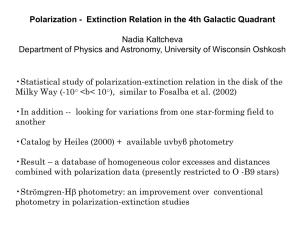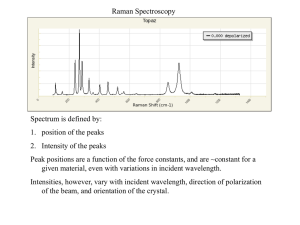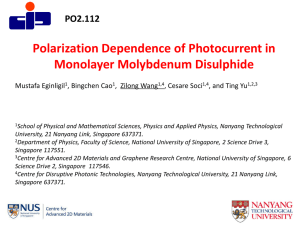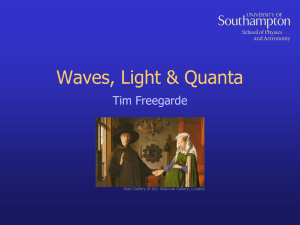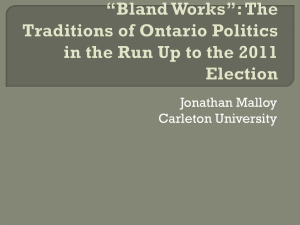Polarization in Astronomy 天文学中的偏振
advertisement
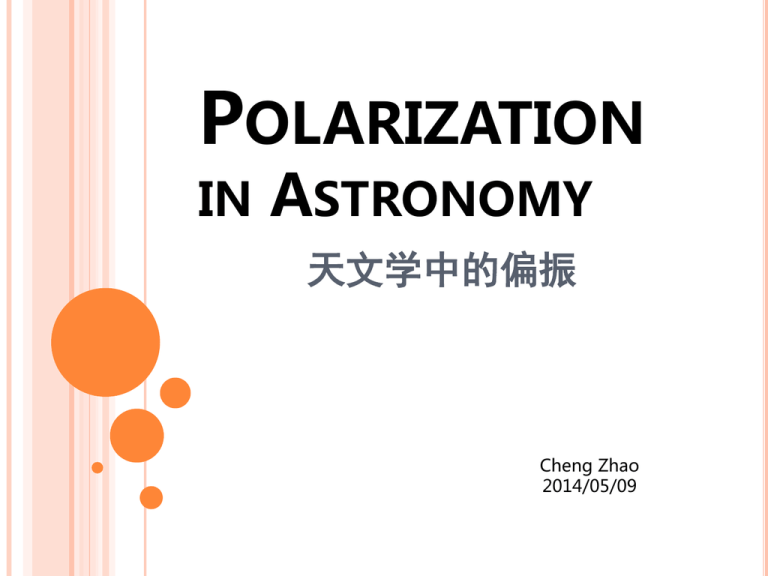
POLARIZATION IN ASTRONOMY 天文学中的偏振 Cheng Zhao 2014/05/09 CONTENTS Introduction Measurement Mechanisms Applications References INTRODUCTION Theory Transverse electromagnetic waves. Electric field 𝑬 is the main component interacting with matter, hence it is used to describe polarization. Polarization: Asymmetry of the oscillation direction INTRODUCTION Classification Basis: oscillation feature of 𝑬 Facing the propagation direction of light, there are only two polarization states (basis): linear polarization in x, y direction. INTRODUCTION QM Description 𝑠=1 Photon 𝑚=0 Eigenvalue of spin gauge symmetry Symbol Helicity = ±ℏ Helicity Polarization state m = -1 -ℏ Left-handed circular polarization m = +1 +ℏ Right-handed circular polarization Transformation with linear polarization basis |𝑥 = 1/ 2 (|𝐿 +|𝑅 ) |𝑦 = −𝑖/ 2 (|𝐿 − |𝑅 ) INTRODUCTION Formalism Stokes vector: 𝑺 = (𝐼, 𝑄, 𝑈, 𝑉)𝑇 Degree of polarization 𝑃 I:intensity Q, U:linear component V:circular component Natural light: P=0 Linear polarization: P=1 (For linear polarization V=0) MEASUREMENT Polarizer – Sheet or Plate Polarizers Sheet polarizer Aligned anisotropic crystals or polymers. Extinction ratio (transmitted intensity for the polarizing direction over that for the perpendicular direction) is typically about 100. Wire-grid polarizer Conducting wires with spacing smaller than the wavelength (From sub-millimeter to optical regime). Fairly large extinction ratios, and applicable over large wavelength ranges. Brewster window A simple piece of glass. The only polarizer in far UV regime. Extinction ratio mostly depends on the incidence angle. MEASUREMENT Polarizer – Polarizing Beam-Splitters Keep all the incident light as output. The polarizer acts as a beam-splitter. Cube beam-splitter with multilayer coating Fairly large extinction ratios are obtained when there are internal reflections at the Brewster angle. Birefringent crystals The refractive index in the crystal is an anisotropic tensor. Incident light that is not in the direction of the crystal axes will be split into two beams with different linear polarization states and speeds. MEASUREMENT 起偏器 MEASUREMENT Retarder Retard the phase of electric field. Manipulate polarization by rotating the angle of linear polarization and thus converting circular into linear polarization. Quarter-wave and half-wave retarders MEASUREMENT Retarder MEASUREMENT Novel Components Mostly owing to developments in the field of nanophotonics and by the liquid crystal display and telecommunications industries. Circular polarizer Based on chiral nanostructures. [Gansel et al. 2009] Passive devices (theta cell) Based on twisted nematic liquid crystals that locally rotate the direction of linear polarization. Many astronomical objects exhibit a centrosymmetric linear polarization pattern around a central source. Such a passive liquid crstal device aligns this pattern in one direction so that only one Stokes parameter has to be measured. [Snik, Frans, 2009] MEASUREMENT Novel Components Polarization grating Such a grating not only acts as a dispersion element, but as a polarizing beam-splitter as well. This polarization grating may replace the combination of a spectrograph and a polarizer. [Packham et al. 2010] Polarization-maintaining (birefringment) fiber Polarimetric versions of fiber-based integral field units. [Lin and Versteegh 2006] MEASUREMENT Detector Similar as other astronomical instruments: low dark current, high linearity, high dynamic range, small gain variations, etc. Read-out noise Polarimetric noise levels should be smaller than photon noise. Nonideal detector properties can create unwanted polarization signals [Keller 1996]. Electron-multiplying CCD (EMCCD) can reduce the influence of read-out noise. Read-out speed Polarimetry often requires fast read-out rates, sometimes >1 kHz. Single-pixel detectors like photomultiplying tubes (PMT) and avalanche photodiodes (APD) can cope with this speed. CCD and other 2D detectors are usually too slow. MEASUREMENT Detector ZIMPOL (Zurich Imaging Polarimeter) Shifting charges back and forth in synchrony with the polarization modulation, without reading out. Developed for VLT for the direct detection of extra solar-planets. Advantage: images in two polarization sates are registered practically simultaneously, no flat field problems. Atmosphric and instrumental aberrations affecting both images are identical. Disadvantage: The many charge transfers and asymmetries of charge transfer limit the polarimetric performance. MEASUREMENT Detector CMOS Each pixel has a individual read-out capacitor [Keller, 2004]. However it may have high dark current. MECHANISMS Scattering and Reflection – Theory Fresnel equations describe the phase shift (electric field) of the reflected light when light moves from a medium into a second medium. If the light is incident at the Brewster angle, the reflection light is perfectly linearly polarized. For complex particles having a preferred handedness (like biology molecules), the reflection light can be circularly polarized. MECHANISMS Scattering and Reflection – Sources Solar system bodies Microphysical properties of small particles like dust grains and atmospheric aerosols can only be unambiguously determined using spectropolarimetry [Hansen and Travis, 1974], such as the small sulphuric acid cloud droplets in Venus’atmosphere. Stellar ejecta and circumstellar material Disks, jets, (AGN) halo, exoplanets, etc. MECHANISMS Multiple Scatering – Theory When aligned dust grains (by magnetic field) are illuminated anisotropically and scatter this light, they can also produce circular polarization. MECHANISMS Multiple Scattering – Sources Interstellar dust aligned with the galactic magnetic field Smallest dimension of nonspherical dust grains are always aligned with the direction of the local magnetic field [Hough, 2007]. Perfect for mapping and understanding the galactic magnetic field structure. Dense molecule clouds Star formation area, disks around young stars (protostar disk and protoplanetary disk). MECHANISMS Cyclotron and Synchrotron Radiation – Theory Non-relativistic electron gyrates around a strong magnetic field: cyclotron radiation. Linear polarization in the direction perpendicular to the magnetic field; circular polarization along the direction of the magnetic field. For relativistic electron, the radiation is synchrotron radiation. Strongly linearly polarized. Circular polarization is also generated when the magnetic field has a net component along the line of sight. In extreme environments, synchrotron radiation dominates. MECHANISMS Cyclotron and Synchrotron Radiation – Sources AGN jets Neutron star Study the structure of magnetic fields. Jet of M87 Crab nebula MECHANISMS Zeeman Effect – Theory Magnetic field modifies the energy of the magnetic sublevels of an atom (-μ·B), and splits the spectral lines. According to the selection law of transition, Δm=0,±1. For Δm=±1, angular momentum of the emergent photon is ±ℏ (projection along the direction of the magnetic field), corresponding to left-hand and right-hand polarization respectively (σ polarization). For Δm=0, the photon has no angular momentum component along the magnetic field direction, and is linearly polarized (π polarization). MECHANISMS Zeeman Effect – Theory Polarization state depends on the orientation of the magnetic field with respect to the line of sight. The emergent light can be red/blue-shifted by the strong magnetic field. Polarization due to Zeeman effect MECHANISMS Zeeman Effect – Sources Sunspot The magnetic field is fairly weak in this case. Large-scale and strong magnetic fields Particularly applies to unresolved stars. Surface magnetic field of SU Aur obtained through Zeeman effect MECHANISMS Hanle Effect – Theory When there is magnetic field along the line of sight, the scattering linear polarization will precess around it, and is mostly depolarized. It is highly complementary to Zeeman effect: the sensitive magnetic field strength is much smaller, typically mG – 100G. Furthermore, Hanle effect can be applied for mixed-polarity magnetic field [Trujillo Bueno, 2006 & 2009]. MECHANISMS 汉勒效应(Hanle Effect)-原理 Hanle Effect Polarization by different directions of magnetic field MECHANISMS Hanle Effect – Sources Sun (corona) A standard tool in solar physics. Stellar atmosphere and stellar wind Brightness and magnetic field of a sunspot group APPLICATIONS Application of Polarization in Astronomy Bastien, Manset, et al., 2011, Astronomical Polarimetry 2008: Science from Small to Large Telescopes APPLICATIONS Solar Physics & Space Physics 目前,太阳表面和内部的许多物理过程和活动现象都还未被完 全了解清楚,主要原因在于获取一些物理参量(如磁场、密度 等)较为困难。 偏振被广泛地应用到了太阳物理中,例如探测日冕的电子密度、 磁场、冕流等。 太阳的许多剧烈活动现象,例如耀斑等,都与太阳上的磁暴有 关,因此偏振的观测还有助于了解太阳活动的过程、预测空间 “天气”。 APPLICATIONS Star Formation and Circumstellar Disks 过去的20年中,星周环境(circumstellar environment)的 模型取得了重大的进展。现在已经有了年轻星体(YSO)周围 尘埃密度分布的详尽模型,包括图像、色图与偏振图。 偏振观测能够给出尘埃的性质与排列,从而检验理论模型。 在更高的分辨率上,偏振可以用于原行星盘的研究。在光学和 近红外波段,偏振可以给出尘埃微粒非常详尽的性质,包括它 们的大小、形状与孔隙等。利用这些性质可以推断尘埃(与行 星)的演化过程和原行星盘动力学模型。 APPLICATIONS Stellar Evolution and Magnetic Stars 2005年后,通过光谱偏振测量,在一些低温度、低质量、充 分对流的主序星上发现偶极主导的磁场,与现有的动力学理论 相矛盾。 偏振观测有助于了解恒星内的对流、对流层与辐射层的相互作 用,从而改进恒星演化和恒星结构的理论模型。 由于对磁场和尘埃散射敏感,偏振还可用来研究演化晚期的星 体,例如中子星、超新星遗迹等。对超新星偏振辐射的研究, 可以推测超新星爆发的一些细节。 此外,由于偏振能够确定一些几何性质,它也被广泛地用来研 究双星,限制其理论模型。 APPLICATIONS Extrasolar Planet Detection 目前已知的地外行星中,大部分都依赖于间接观测,因为它们 相对于宿主恒星而言太昏暗了。考虑到行星反射的光是高度偏 振的,而恒星发出的光在很大程度上不具有偏振特性,现在偏 振正被用来探测地外行星。 理论上讲,对地外行星的偏振观测可以获取大量信息,例如轨 道倾角、质量、大气微粒性质、反射率、行星半径、温度等。 偏振测量因而被当作将来地外行星探测的重要手段,并能对行 星大气模型给出更多的约束。 偏振可以用于对行星云层或海洋组成的研究,而一些复杂的生 物分子能散射出圆偏振光,因此偏振又是极少的能够探测地外 生命的方法之一。 APPLICATIONS Interstellar Medium 从上世纪50年代起,就提出了尘埃排列理论,用以解释银河系 中的线偏振。近几年该理论取得了显著进展。 偏振光谱能够确定尘埃的组成、大小、增长和消失,从而确定 分子云与星际介质的相互作用。 在远红外和亚毫米波段观测到的去偏振效应需要用磁场来解释, 而偏振观测可以很好地确定磁场的性质,但仍需要更多高空间 分辨率的观测。 对恒星形成星云的圆偏振观测,还可能使我们了解地球生物分 子同手型的来源。 APPLICATIONS Galaxies and AGN 偏振在AGN统一模型的建立和发展上起了重要作用。 最近的高空间分辨率偏振观测显示出核附近的信息,有助于发 展AGN的统一理论,和研究AGN与宿主星系的相互作用。对 更高红移处AGN的偏振研究可能使我们了解AGN的演化和与 环境的相互作用。 在光学和近红外波段的光谱偏振测定,可以确定无法直接分辨 出的几何结构和散射颗粒的运动速度。 APPLICATIONS Cosmology 宇宙微波背景(CMB)的偏振在微开尔文的水平,有两种偏 振模式,称为E模式和B模式。 CMB的偏振证实了早期宇宙密度的不均匀性(各向同性的入 射光通过汤姆孙散射无法产生偏振),更进一步,CMB偏振 的研究,可以确定早期宇宙密度(温度)起伏的性质和成分。 通过CMB偏振的研究,可以获知宇宙早期的信息,以及宇宙 大尺度结构的形成。 REFERENCES Snik, Keller, 2013, Astronomical Polarimetry: Polarized Views of Stars and Planets, Springer Science+Business Media Dordrecht, p.175 Bastien, Manset, et al., 2011, Astronomical Polarimetry 2008: Science from Small to Large Telescopes 赵凯华, 2004, 新概念物理教程·光学, 高等教育出版社 Schmid, Gisler et al., 2005, ZIMPOL/CHEOPS: a Polarimetric Imager for the Direct Detection of Extra-solar Planets Trujillo Bueno, 2009, Diagnostic methods based on scattering polarization and the joint action of the Hanle and Zeeman effects Raouafi, 2011, Coronal Polarization Hough, 2007, New opportunities for astronomical polarimetry, J. Quantit. Spectr. Rad. Transfer, 106, 122–132
